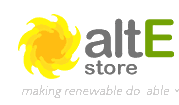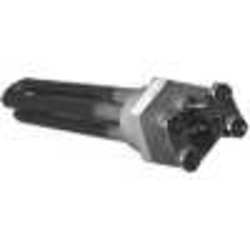- FEATURED PRODUCTS
- Solar Panels
- Solar Power Systems
- Productos Solares en Puerto Rico
- Charge Controllers
- Inverters
- Deep Cycle Batteries
- Solar Panel Mounts
- MORE PRODUCTS
- Cables & Wiring
- Enclosures, Electrical & Safety
- Inverter Power Panels & PreWired Systems
- Meters, Communications & Site Analysis
- Portable Power Systems
- Solar Water Pumps
- Voltage Converters
- Wind Turbines
- Books & Education
- * Clearance Sale *
- Hot Deals
- Open Box & Refurb Deals
Water Heating Element for 12V or 24V DC - 1" NPT Male
| Item code | Brand name | Model number |
| ALR-12/24-WHE | AltE | 12/24 VOLT |
Alternative Energy Engineering
Low Voltage Water Heating Element
Diversion Load
_250px.jpg)
Diversion Load Information
In most hydroelectric and wind-powered battery charging systems, the charging source cannot be disconnected from the batteries while running without the possibility of damaging them from over-voltage. The typical way to regulate battery charging voltage with this type of generating system is to use a“load diversion” type charge control. The Morningstar TS45 and TS60, the Xantrex C40 and C60 and the Outback MX60 can be configured for this mode of charge control. A diversion-type charge control also may be used in a PV system. If the array is much larger than necessary to charge the battery, excess power can be used to heat water by using a water heating diversion load. In operation, when battery voltage reaches the full charge setting in the charge control, it begins to divert power to the diversion load. The control uses pulse width modulation to turn the load on just enough to keep the battery voltage from rising further. The critical requirements are that the diversion load can dissipate more watts than the charging source can deliver, and that the maximum amperage that the load can draw is smaller than the maximum diversion rating of the charge control. We recommend that you do not use a load that draws more than 75 percent of the maximum rating of the charge control. For example, if the charging source can deliver 20 amps at 24 volts, use a 30 amp diversion load with a 40 amp or larger charge control.
Regulation voltage: |
14.00 |
28.00 |
56.00 |
|||||
Model |
Wiring |
ohms |
amps |
watts |
amps |
watts |
amps |
watts |
| 12v/24v | Series | 0.96 | 14.6 | 204 | 29.2 | 817 | ||
| Single | 0.48 | 29.2 | 408 | |||||
| Parallel | 0.24 | 58.3 | 817 | |||||
| 24v/48v (12v also) |
Series | 2.48 | 5.6 | 79 | 11.3 | 316 | 22.6 | 1265 |
| Single | 1.24 | 11.3 | 158 | 22.6 | 632 | |||
| Parallel | 0.62 | 22.6 | 316 | 45.2 | 1265 | |||
For Lakota Wind Turbine Applications:
For the 12V model please use QTY 2 of this unit with each
sub-element in Parallel and connecting the 2 whole elements in Series.
For the 24V model please use QTY 2 of this unit with each sub-element in Series
and connecting the 2 whole elements in Parallel
For the 48V model please use QTY 2 of this unit with each sub-element in Series
and connecting the 2 whole elements in Series.








